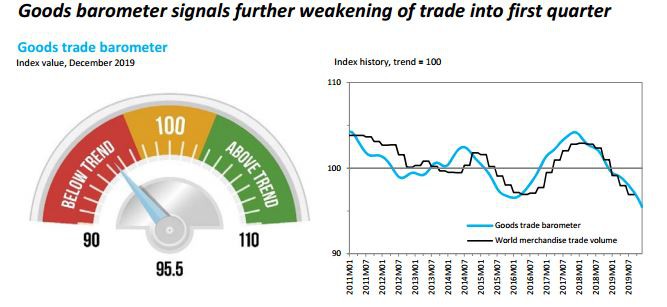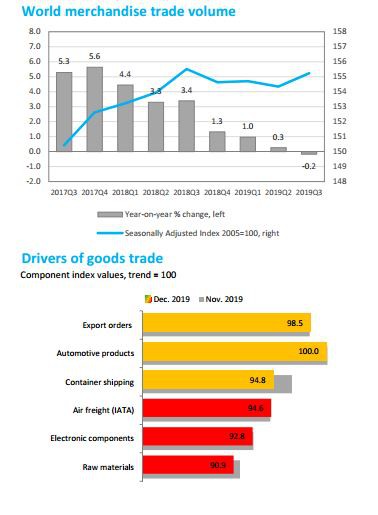How Does The World Trade Index Of Goods Look At The Epidemic Situation In WTO?
The latest goods trade barometer released by the World Trade Organization (WTO) shows that the growth of global commodity trade at the beginning of 2020 still looks weak without taking the relevant impact of the new coronavirus epidemic into account.
The benchmark value of the WTO's goods barometer is 100, with 95.5 as of February, down from 96.6 in November last year. A reading usually below 100 indicates that trade growth is below the medium-term trend.
The WTO warns that this situation may be affected by a new round of global health threats in the future.
The agency's trade statistics also show that global trade in goods fell by 0.2% in the third quarter of 2019 compared with the previous year. Although the year-on-year growth in the fourth quarter is likely to pick up slightly, there is no sign of a sustained recovery.
The WTO points out that this means that the year-on-year growth of trade in goods in the first quarter of 2020 may decline again, but the relevant official statistics will not be released until June this year.
Earlier, during the annual meeting of the world economic forum at the end of last month, WTO director general Roberto Azevedo pointed out in a dialogue with the media including first finance and economics that the trade growth situation in 2020 is expected to be better than that in 2019. Global trade expanded by 2% in 2019, and is expected to grow by about 2.7% year on year. "We are still in the decline channel, but there are no particularly dramatic changes."

Container transportation and agricultural raw material trade continued to decline
The world trade in goods barometer provides early signals on the development trend and inflection point of the world trade in goods by collecting statistical data of the trade in goods. It is updated once a quarter. Generally, when the value exceeds the benchmark value of 100, it indicates that the global trade in goods tends to grow. When the value is less than 100, it indicates that the trend of the global trade in goods is weak.
This time, from the perspective of each sub item, since November last year, the commodity trade index began to decline, mainly due to the further decline of container shipping index (94.8) and agricultural raw material index (90.9) and the stagnation of automobile production index (100).
At the same time, although the export order index (98.5), the air cargo index (94.6) and the electronic parts index (92.8) are all below the benchmark level, such indexes seem to have stabilized and are expected to gradually rise in the coming months.

However, the WTO is careful to point out that the current outbreak of new coronavirus and its control effect will affect every component of the commodity trade index.
As mentioned earlier, the WTO did not include the factors influencing the outbreak of new coronavirus in the barometer.
Previously, Azevedo pointed out that the WTO predicted that the growth of trade expansion in 2020 would be in the range of 1.7% - 3.7%, but even so, it is lower than the historical trend.
"It's not too much to celebrate. 2019 is probably the worst year for Global trade expansion in more than a decade." Azevedo pointed out.
The spillover effect of the global economic impact of the new crown epidemic is limited
In addition to the WTO, international agencies and statistical agencies have recently issued relevant expectations.
Both the International Monetary Fund and the world bank have pointed out that China has enough policy space to deal with the new coronavirus epidemic, and China's efforts have reduced the risk of impact on the world economy.
IMF President Georgieva said that the IMF has begun to comprehensively assess the impact of the epidemic on the global economy, but "there are still many uncertainties".
She pointed out that in terms of the economic outlook, with the restart of factories and the replenishment of inventories, China's economy is expected to recover rapidly; the most likely situation is "V-shaped" growth, that is, the economic activity will recover rapidly after the decline, and the overall impact of the epidemic on China's economy is relatively controllable.
With regard to the impact of the epidemic on the global economy, Georgieva said that the mode of impact of the epidemic on the economy and the value chain is still uncertain.
Compared with the outbreak of SARS in 2003, China's economy means much more to the world, accounting for 19% of the world economy from 8% at that time, and the degree of integration of Asia and the rest of the world is also higher. With the gradual recovery of China's economy, the impact of the epidemic on the global economy is expected to be controlled.
With more data released in the next week to 10 days, the IMF will continue to carefully assess the impact of the outbreak on the economy and improve its economic forecast, Georgieva said.
In the 2020 winter economic outlook (hereinafter referred to as "Outlook"), the EU pointed out that the presumptive baseline of the EU is that under the current situation, the impact of the new coronavirus epidemic on China's GDP mainly refers to the first quarter, but its global spillover effect is relatively limited.
In the future, it is pointed out that the current outbreak of new coronavirus has a great impact on China's service industry, especially the outbreak coincides with the new year's holiday. However, any current assessment of the impact of the epidemic on the economy will be affected by greater uncertainty, which mainly depends on the duration of the epidemic and other factors.
Looking forward, it is pointed out that with the subsequent easing of various interference situations and the beginning of catching up of production and demand, it can be presumed that the economy will recover in the next few quarters, while the macroeconomic situation may also be buffered by additional policy incentives.
However, the outlook also points out that the new coronavirus epidemic may have an impact on foreign trade and supply chain, and the German industry has a large exposure to it.
In its outlook, the EU judged that despite the risks, the European economy will continue to maintain steady and moderate growth.
The outlook forecasts that GDP growth in the eurozone will remain stable at 1.2% in 2020 and 2021. For the EU as a whole, growth is expected to slow slightly to 1.4% by 2020 and 2021, slightly lower than 1.5% in 2019.